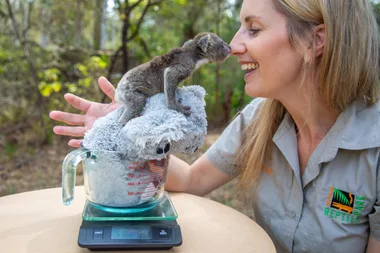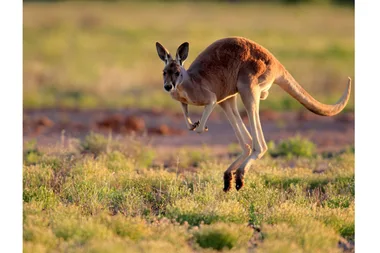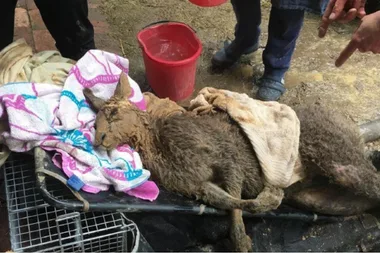- Mandy Watson, 58, from Kununurra, WA is a wildlife carer
- She’s been saving kangaroos for the last two decades
- Now a nan to four grandchildren, they all love visiting from Perth and spending time with the joeys
Here Mandy tells her story in her own words.
Cradling the baby joey in my arms, I felt my heart might burst with love.
‘You’re safe now,’ I cooed as the orphan, who we named Lulu, peered at me with her big brown eyes.
It’s all in a day’s work for a wildlife carer.
Though I’ve loved animals all my life, it was only when my hubby Marc, then 40, and I rescued a five-month-old joey from her mum’s pouch, back in September 2005, that we learned the ropes of caring for these Aussie icons.
Naming her Midnight and taking her home, our kids Charlene, then 18, and Trudi, 17, were filled with excitement meeting their new fur sibling.
Taking Midnight to get checked at our local vet, I learned the importance of keeping her warm, and the need for round-the-clock feeds with special formula to help her thrive.
It was incredible watching the joey go from strength to strength over the coming months.
When she started hopping around our two-bedroom apartment 18 months on, we knew she was finally ready to go back into the wild.
It was bittersweet as we waved her off at a national park, but I knew it was for the best.
‘Sometimes we had 20 baby kangaroos at home.’
Afterwards, I wanted to help as many other animals as I could.

By day I worked as a teacher’s aide with the disengaged youth at our local school in Kununurra, and by night I teamed up with our local vet caring for joeys that needed help.
I even trained with the Parks and Wildlife Service to learn how best to rescue and rehabilitate wildlife.
As word spread around town of my side gig, more joeys in need of a home began arriving on our doorstep. Sometimes we had up to 20 baby kangaroos in our apartment at a time, their enclosures spread across our spare room and dining room, with the rest in our courtyard.
As joeys need to be fed every four hours, I juggled my full-time work with full-time caring and often brought babies to school in a thermal picnic basket.
‘Did you know kangaroos are lactose intolerant?’ I’d tell the kids, who were all fascinated by the babies.
In May 2010, aged 43, I officially registered Kangaroo Haven Wildlife Rescue as a not-for-profit charity.
In 2011, we said goodbye to our apartment and moved to a 10-acre block. While I managed round-the-clock feeds, cleaning and care, Marc got to work building large enclosures.
We designed a large shed with sections, so we could group the roos based on age and care needs.
Over the next few months, we took in 15 wallabies, an emu, nine kookaburras, an eagle, a brolga, 10 sugar gliders, 10 magpie geese, 50 ducks, 50 chooks, two pigs, four snakes – and a parrot!
Opening the cupboard to make a cup of tea, I often found a sugar glider curled up inside a teacup.
‘That’s not where you belong,’ I’d laugh.
To help cover the cost of running a charity, after school I ran tours on the property, where I taught visitors what is involved in looking after roos.
Caring for orphaned newborn joeys, called pinkies, whose eyes were yet to open and who were still to grow hair on their fragile pink skin, was especially difficult.

‘Only one in 25 pinkies who arrive at the centre with their eyes shut go on to survive,’ I explained to groups.
Then, in September last year, I was ecstatic when local nurse Jane Darlington called me with a lifeline.
‘We have two old incubators here at the hospital. Would you like them?’ she asked. Advancements in technology meant the incubators were no longer fit for use in the ward, but they’d make perfect pseudo-pouches.
Up until now, I’d been using a tiny portable incubator I purchased online that only fitted one pinkie at a time.
‘I’ll take them!’ I replied.
Incredibly, up to six pinkie joeys could fit in the 1m x 40cm incubators at one time.
‘It never gets easier to say goodbye.’
Our pinkies now live in an incubator for one month, or until their eyes open and their fur grows in.
And their survival rate has doubled!
After around 16 to 18 months in care, the joeys are typically weaned off milk, and are ready to be returned back to the wild.
We’ll often take 12 at once to a national park six hours away, where they are protected from shooting and traffic.
‘Be safe babies,’ I sob as the kangaroos hop into the distance.
Despite all the years that I’ve been doing this, it never gets any easier.
In all that time, only one roo, Lulu, decided the wild wasn’t for her and hopped after us on the drive home.
‘I guess you can stay, sweetheart,’ I soothed on the third attempt to release her, knowing she was too used to being with us humans to survive back in the wild.
Eight years later, kangaroo Lulu is living her best life at home alongside the 50 other roos currently in our care.
It’s nearly 20 years since we started our rescuing journey and Charlene, now 39, and Trudi, 38, couldn’t be prouder.
I’m now Nan to four grandies, Allyarna, 17, Taz, nine, Kalani, seven, and Lavinayah, two, and they all love visiting from Perth and spending time with the joeys.

‘I’ve released 853 kangaroos back into the wild,’ I tell them excitedly.
While the number of animals in our care seems to be constantly growing, we wouldn’t have it any other way.
We’re one big hoppy family.
Visit kangaroohavenwildliferescue.com.au



